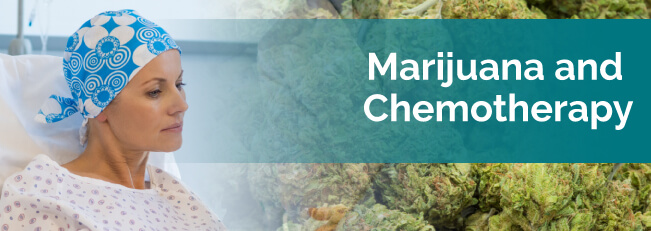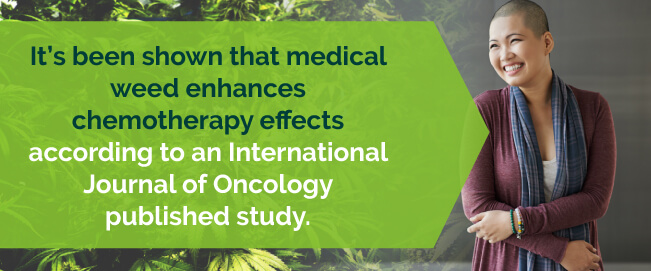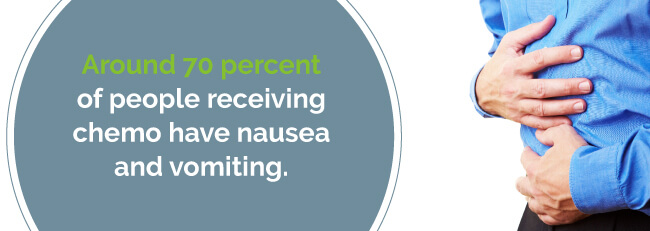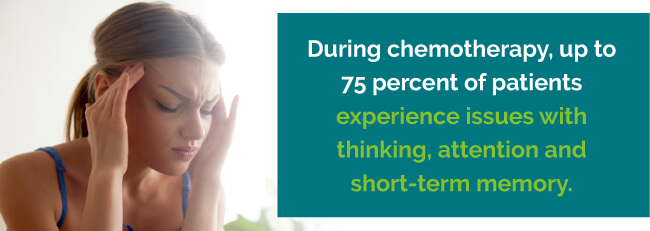
There are many ways patients use marijuana in their cancer treatments. Some people use it to manage their cancer symptoms like pain, nausea, and vomiting. Others take cannabis to boost their mood on their difficult days. But medical marijuana for chemotherapy may also be something they can turn to.
Each year, researchers gain more knowledge about how marijuana interacts with people’s bodies. Although researchers still need more information, we know that cannabinoids, which are the active compounds in marijuana, engage your endocannabinoid system (ECS).
Your endocannabinoid system is a vast network of cell receptors responsible for several bodily functions that include:
According to the National Cancer Institute, the active chemicals cannabinoids found in medical weed cause drug-like effects in your body, including your immune system and central nervous system. The primary active cannabinoid in marijuana is delta-9 THC. Cannabidiol (CBD) is another active cannabinoid in cannabis that can reduce lower inflammation, decrease anxiety and relieve pain without giving you the “high” that delta-9 THC produces.
Marijuana for chemotherapy and the cannabinoids in it seems to have benefits in treating cancer symptoms and cancer therapy side effects. In fact, studies in the clinic and laboratories show that medical pot and cannabinoids can relieve nausea and vomiting, pain, loss of appetite and anxiety.
Find A Doctor Find A Dispensary

Over 85 cannabinoids make up the cannabis sativa plant. Some of these chemical compounds also exist in your body. Much like opioids activate your opioid receptors and limit your perception of pain, marijuana cannabinoids activate your cannabinoid receptors. These receptors are in various areas of your body such as your liver, brain and immune system.
According to the University of Pennsylvania’s Perelman School of Medicine’s Dr. David Casarett, marijuana and chemotherapy treatment is the most efficient in palliative care, or managing your symptoms and improving your quality of life.
The side effects of chemotherapy that medical cannabis can influence include:
It’s also been shown that medical weed enhances chemotherapy effects according to an International Journal of Oncology published study.
In a study conducted by Massachusetts General Hospital, medical cannabinoids far outperformed other antinausea drugs for adolescents being treated with chemotherapy.

Several strains of medical cannabis help with chemotherapy side effects. Each strain has its properties that help with chemo side effects. Some include:
Just remember, each strain comes with its unique distinct effect profile. What may work well for one particular side effect of chemotherapy might not be effective for another. Therefore, you may have to go through some trial and error before you find the best strain or strains that work for your chemo-related side effects.
When consuming your cannabis for chemotherapy, you have a handful of methods of use you can try out. It’s difficult to recognize the “best” method of consumption, particularly since you have new several ways to take cannabis.
The oldest practice is smoking the herb, although vaporizers are also becoming more popular. Edibles are another popular method, since you can delight in all your favorite foods with a little bit of THC love in it. Along with these three popular methods of medical pot use, there are spray and oil methods as well.
You can drink, smoke and eat cannabis. You can also apply marijuana on your skin, and even use cannabis in the form of a suppository.
Many patients juice their raw cannabis or wear it as a transdermal patch in an attempt to use a natural remedy to treat the adverse side effects of their chemo treatments.
So, now that you’ve decided you’re interested in venturing down the cannabis and chemotherapy path, the next step is to utilize resources to obtain medical cannabis for chemotherapy. Just like with any other big decision you make in your life, you’ll want to conduct research to figure out what the best options are for you. Just remember, before you can begin your medical cannabis treatment, you first must obtain a recommendation from a doctor and a medical marijuana card. Therefore, your first step is to search for a medical cannabis dispensary or find a marijuana doctor.
Find A Doctor Find A Dispensary
While doctors use chemotherapy to treat many diseases, most people think of chemo as a cancer treatment. Although radiation therapy and surgery kill or remove cancer cells in specific areas, chemotherapy works throughout your entire body. It eradicates cancer cells, including those that have metastasized or spread to other areas of your body away from the primary tumor.
If your doctor suggests chemo for treating your cancer, you need to understand your treatment goals. Chemotherapy has three primary goals in cancer treatment:
Control Cancer: This occurs when chemo slows the growth of your cancer, keeps it from spreading or destroys cancer cells that have spread to other areas of your body.
Ease Cancer Symptoms: In this case, the chemo is used to shrink the tumors that cause you pressure or pain.
Cure Cancer: The goal here is to use chemo to destroy cancerous cells to the point where your doctor can’t detect them any longer in your body, and they don’t grow back.
Sometimes, people receive only one type of chemotherapy. Others may get two or more types of chemo simultaneously. Doctors perform this action to help attack cancer in various ways. The dose and type of chemotherapy you receive depends on several things including:
Although not a thorough list of chemo drug classes, the medications listed below can provide you with an idea of how chemotherapy medications are classified and the way the work. Doctors may also combine them to attack your cancer cells in several ways. Different types of chemo may include:
No matter what type of chemotherapy you use, you will almost certainly experience side effects. By being prepared and talking with your doctor, you can better manage your side effects.
Chemotherapy developed at the start of the 20th century. At the time, however, it wasn’t intended as a treatment for cancer. Louis Goodman and Alfred Gilman, two Yale pharmacologists, evaluated mustard agents and their therapeutic effects in the 1940s for treating lymphoma.
In the 1960s and early 1970s, combination chemotherapy’s ability to cure advanced Hodgkin’s disease and acute childhood leukemia overcame the general pessimism about chemo’s ability to cure advanced cancers. During this time, the study of accompanying chemo and support to the national cancer program began.
Cancer survivor numbers continue to increase in the U.S. despite the generally stable rates in women and declining of cancer rates in men. This demonstrates the increase in new diagnoses of cancer resulting from an aging and growing population. It also explains an increase in the survival rate of cancer due to advances in treatment and early detection.
Chemo typically causes severe adverse side effects. However, due to advances in science, these are more manageable now than in the past. Your side effects may range from mild to severe depending on the type of cancer treatment and extent of it, along with other factors. Some individuals don’t have any adverse effects. Below are some adverse effects you may experience.

Around 70 percent of people receiving chemo have nausea and vomiting. Certain anti-emetic drugs can help with these symptoms, although you’ll have to take them even after your symptoms have passed to keep your symptoms from returning.
Chemotherapy treatment can help as well, which you’ll learn more about a little further down in this article.
During chemotherapy, up to 75 percent of patients experience issues with thinking, attention and short-term memory. Around 35 percent of these patients continue to experience these symptoms after treatment for months or even years. Chemo may also affect your ability to organize, reason or multitask. Depression and mood swings are also possible, whether due to fear of the future or fear of the treatment itself.

Hair loss is another side effect of chemo. Your hair may become brittle, thin and fall out a few weeks after you begin chemo treatment, depending on your treatment. While there are no physical health consequences of hair loss, it still could cause you distress. Your doctor may recommend wearing a wig or, if losing your hair affects you more deeply, seeing a counselor.
Chemotherapy’s toxic effects can cause temporary or permanent hearing loss.
When you receive chemo, your immune system weakens because of the decrease in your white blood cells — a condition known as neutropenia. Your white blood cells make up part of your immune system and fight infection. When they are limited in number, it makes you more susceptible to infections. Your doctor may put you on antibiotics to help keep you from developing infections. You should take recommended precautions to lower your chances of infections too.
These include:
When you’re receiving chemo, and you develop an infection, you need treatment immediately. You may require staying at the hospital and receiving intravenous antibiotics if you contract an infection.
Your body tissues receive oxygen from your red blood cells. When your red blood cells are low, it could lead to anemia. Anemia symptoms include shortness of breath, heart palpitations and tiredness. If you have severe anemia, you may have to get an urgent blood transfusion.
Your doctor may give you Erythropoietin (EPO) which helps your body make more red blood cells. Another way to avoid anemia is by eating good food sources rich in iron like beans, nuts, leafy vegetables, raisins, meat and apricots.
Also referred to as thrombocytopenia, you may experience blood clotting problems as a result of chemotherapy. Your platelets are a form of blood cell that helps your blood clot or coagulate. When you have a low platelet count, it can result in bleeds or bruises, such as bleeding gums and nosebleeds. Stopping a minor cut from bleeding can be hard. If your platelet count gets to be too low, you’ll require a blood transfusion.
To reduce your chances of bleeding, you should:
Mucositis is mucous membrane inflammation. The condition can affect parts of your digestive system like your esophagus, mouth, rectum, intestines, anus and stomach. Taking oral mucositis may cause symptoms of your mouth. These symptoms, including a burning sensation in your mouth, usually start around seven to 10 days after you start treatment.
You may also develop ulcers that appear on your tongue, around your lips and on the lining of your mouth. It may be painful to drink, eat and talk. If you experience bleeding, it could lead to infection. The chemotherapy dose you receive determines the severity of your symptoms. Your doctor may prescribe you caphosol for your mucositis. Once you complete treatment, your symptoms should disappear.
Many patients experience fatigue after chemotherapy. You may experience it after you perform certain activities or most of the time. Avoid tasks that make you tired and get plenty of rest. Report severe tiredness to your doctor since this could indicate a substantial drop in your red blood cells, which could lead to anemia. Medical cannabis helps reduce fatigue, particularly sativa strains since they produce energizing effects.
During chemo, you may lose interest in sex temporarily. Once you finish treatment, however, your libido will likely return. Depending on the type of chemo you receive, your fertility may decrease. Fertility usually returns after your chemo is over, but not always. You might want to consider freezing embryos or sperm to use later.
Either chemo or your cancer itself can affect your metabolism, which can lead to a loss of appetite. When you don’t have much interest in food, you don’t eat, and this leads to weight loss. These symptoms will persist until your chemo treatment is complete.
By taking more frequent, smaller meals, you can continue to nourish yourself. If you’re unable to consume food or drinks altogether, you’ll need to stay in the hospital where the doctor will insert a nasogastric tube through your nose that goes straight to your stomach to feed you. Cannabis for chemotherapy is widely-known to increase your appetite, hence the term “munchies.”
Several chemo medications could cause congenital disabilities. Therefore, it’s best that while you’re receiving treatment, you avoid becoming pregnant. During treatment, you may want to use a barrier birth control method and continue this birth control for a minimum of a year after. Avoid oral birth control methods since they could interfere with your chemotherapy treatment. If you become pregnant during treatment or already are, tell your doctor immediately.
As chemotherapy damages cells and they are expelled from your body, you could end up with diarrhea or constipation. Both usually start several days after you begin treatment.
Facts reported by CA: A Cancer Journal for Clinicians show: